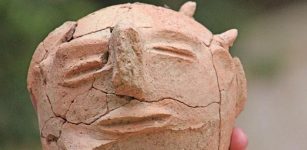Human Footprints Of People Who Used Caves Of Ojo Guareña, Burgos 4600 Years Ago
Conny Waters - AncientPages.com - Old human footprints have been found in many places around the world. Some of them are very old and some only thousands of years old. The fascinating Zapata footprint is believed to be 290 million years old, is a mystery because it was left by "someone" and this individual's foot resembles that of a human.
Also, a set of controversial, about 5.7 million years old human-like footprints from Trachilos in western Crete, is no doubt putting theory of human evolution to the test.
Now, the prints of bare feet have been studied by the CENIEH researchers at the Sala y Galerías de las Huellas site in the Ojo Guareña Karst Complex, Burgos, Spain. These footprints are not so old as the ones just mentioned above. They were left in soft floor sediment of exploration by a small group of people between 4600 and 4200 years ago.
 Human footprint. Credit: Galería de las Huellas I)/Miguel Ángel Martín Merino
Human footprint. Credit: Galería de las Huellas I)/Miguel Ángel Martín Merino
In 1969, researchers of GE Edelweiss discovered hundreds of ancient human footprints, preserved in the soft sediment on the floor of the Sala and Galerías de las Huellas in Ojo Guareña Cave system, in Burgos, Spain.
Burgos is an interesting place. In 2020, researchers studied cave art in the Sala de las Pinturas (‘Painting Room’) at Ojo Guareña (Burgos) and could confirm that the art is over 12,000 years old.
The researched area of the "Painting Room" is one of the largest cavities in the world covering some 110 km, and apparently, it was frequently visited and used more than twelve millennia ago.
As to the footprints recently found, they represent the tracks of a small group of people who walked barefoot through these complex passages in the cave. Owing to the difficult compatibility of the documentation and preservation of these prints, it was not possible to study them
Dating carried out in the access galleries to this site has documented intensive human traffic during the Neolithic, Mesolithic, and Upper Paleolithic, confirming reiterated visits to this great cave complex throughout prehistory.
 Footprints, Burgos Spain. Image credit: Ana Isabel Ortega/Researchgate.net
Footprints, Burgos Spain. Image credit: Ana Isabel Ortega/Researchgate.net
These footprints, ascribed to traces left by about ten individuals who explored the caves between 4600 and 4200 years ago, were discovered in 1969 by Grupo Espeleológico Edelweiss (GEE) at the Sala y Galerías de las Huellas site, some 1200 m from the entrance to Palomera Cave.
The fragility of the footprints and their environment meant it was not possible to study them, and doing so has had to await the development of the new non-invasive teledetection techniques.
 Galería de las Huellas I/Miguel Ángel Martín Merino. Credit: CENIEH
Galería de las Huellas I/Miguel Ángel Martín Merino. Credit: CENIEH
"Thanks to 3-D scans and digital photography, in combination with GIS techniques, we have been able to meticulously identify over 1200 human footprints at this site," explains the archaeologist Ana Isabel Ortega, a researcher at the CENIEH and the Fundación Atapuerca who led this study.
"The exceptional nature of these incursions is due to how complex access is. Studying the route taken by the explorers and their trackways is enabling us to learn more about how the subterranean world was used in prehistory, and especially about the use of the dark zone as part of the journey toward a symbolic and social landscape," adds Ortega.
Of the samples dated, six are from the itineraries where the prints of bare feet are preserved, with dates ranging from 4600 to 4200 years ago (Chalcolithic). However, along the access conduits, the chronological range expands considerably. Apart from two Chalcolithic dates situated in the immediate access to Sala de las Huellas, four samples were documented between 6600 and 6200 years ago (Neolithic) and three others between 7800 and 7700 years ago (Mesolithic).
The most ancient is dated to around 19000 years old (Upper Paleolithic).
"The advances in the prehistoric research at Ojo Guareña are underlining the intensive and reiterated use of the subterranean world during prehistory," concludes Ortega.
The study with photos is available - here.
Written by Conny Waters - AncientPages.com Staff Writer



















